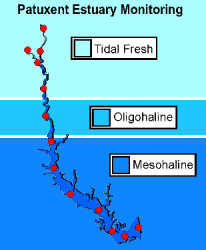Complexity and Stressors in Estuarine Coastal Ecosystems
(COASTES)
ISSUE
The coastal region of the U.S.
is rapidly changing. Since 1960, the coastal population has increasedby 32
million and may increase by another 15 million in the next 20 years. The combined
impacts of this population shift -- habitat modification, excess nutrient
and toxic inputs, and fresh water diversions -- are poorly understood. Traditional
management responses to coastal degradation have been focused on individual
causative factors (e.g., toxins, nutrients, habitat loss) rather than on the
interactions of all those stressors in nature. In fact, organisms do not respond
to a single stressor, but to a suite of stresses present in their environment.
Better understanding of these cumulative effects and development of integrative
approaches to predict these effects is necessary for more effective management
of coastal resources.
APPROACH
The COP's Complexity and Stressors
in Estuarine Systems Project (COASTES) is a 6-year study of the cumulative
effects of multiple stressors in the Patuxent River,
a sub-estuary of the Chesapeake Bay
. The goal of this research
program is to develop an approach for understanding and predicting the effects
of multiple stressors on the natural system, living resources, and associated
economies. The stressors
under study, identified as having negative impacts in the Chesapeake, are
excess nutrients (nitrogen and phosphorus), toxic contaminants (arsenic, copper,
and cadmium), and low dissolved oxygen. Support for this project began in
1995 and will be completed in 2003.
 The
key question is how does the estuary respond to a suite of stressors, from
the microscopic algae, to oysters and clams, on up to schools of large fish?
To address that question,
investigators are quantifying the input of stressors to the estuary, conducting
experimental studies of the effects of these stressors on ecological processes,
and modeling the ecological effects of natural and anthropogenic stress from
the individual organism to ecosystem level. Experimentation to quantify the
effects of multiple stressors is conducted in a series of large tanks with
different stressor treatments and varying levels of ecological (i.e., food
web or trophic) complexity. Preliminary findings indicate that the effects
of excess nutrients and toxic elements are non-additive, seasonally dependent,
and can change the species composition of the micro-algae population. The
later can have a cascading effect on clams, oysters, and even fish, which
depend directly or indirectly on micro-algae for food.
The
key question is how does the estuary respond to a suite of stressors, from
the microscopic algae, to oysters and clams, on up to schools of large fish?
To address that question,
investigators are quantifying the input of stressors to the estuary, conducting
experimental studies of the effects of these stressors on ecological processes,
and modeling the ecological effects of natural and anthropogenic stress from
the individual organism to ecosystem level. Experimentation to quantify the
effects of multiple stressors is conducted in a series of large tanks with
different stressor treatments and varying levels of ecological (i.e., food
web or trophic) complexity. Preliminary findings indicate that the effects
of excess nutrients and toxic elements are non-additive, seasonally dependent,
and can change the species composition of the micro-algae population. The
later can have a cascading effect on clams, oysters, and even fish, which
depend directly or indirectly on micro-algae for food.
These results, along with data
gathered on the watershed, water quality, and local economy, are now being
used to build models of watershed loading of stressors, water quality, trophic
interactions, risk assessment, fish growth, and economic outcomes. Applications
of those models will include evaluating stressor management strategies and
their outcomes on the environment and related economies. For example, resource
economists are constructing models to predict the effect of changing water
quality on the abundance of recreational fish, and what those changes could
mean to the economics of sport fishing.
It is expected that the
approach, results, models and techniques developed in this study will be applicable
to other coastal ecosystems.
Related Websites
For
more information, contact:
Susan Banahan
CSCOR/Coastal
Ocean Program
phone: 301-713-3338
e-mail: coastalocean@noaa.gov
Last Updated:
November 12, 2002



